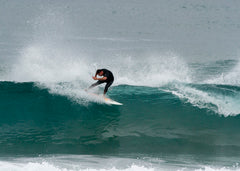Design Notes: Go Wide or Go Home
 Bite your tongue, we're talking about surfboards.
Bite your tongue, we're talking about surfboards.
If you you're a Floridian, Southern Californian, or a Gulf Coaster... you're starved for waves right now. Sure it's surfable, but not by much. If you've got short arms and deep pockets, you may not have a backup longboard to switch to and your shortboard isn't quite cutting it. In other words, you're the guy in the lineup thinking "wheeeen are we gonna get some sweeeeell." Meanwhile, everybody on anything with obnoxious volume is having a blast, no matter how kooked out they look. They're still having more fun than you.
What you're realizing is, all the pro models, even their small wave editions, are built for word class surfers surfing good waves in less than desirable conditions. That board wasn't built for you, nor your wave. (See Huntington Beach: U.S. Open)
What you need is more volume. A LOT more volume. Don't be scared. What looks goofier than a chunky board being surfed in junky waves? That guy on a shortboard that's chop-hopping the entire wave. The reason that's happening is there isn't enough power on hand. When you're struggling to build speed, you need more planning surface area underneath you.
 A shorter board with flatter rocker, fuller nose, tail and rails, will keep you moving across the water without sinking, in turn, keeping your speed up. When you go to make a quick turn, the board will make the full wrapping rotation before hitting the trough in front of the wave. Basically, a shorter board means shorter turning radius. This keeps you tight in the pocket where the wave's power source is.
A shorter board with flatter rocker, fuller nose, tail and rails, will keep you moving across the water without sinking, in turn, keeping your speed up. When you go to make a quick turn, the board will make the full wrapping rotation before hitting the trough in front of the wave. Basically, a shorter board means shorter turning radius. This keeps you tight in the pocket where the wave's power source is.
I'm not saying you need a 5 foot long, 23 inch wide mini simmons to make the summer bearable. I'm saying you just need a fuller outline than a standard shortboard... and by doing so, you can shorten your board so that it fits into the pocket easier when ripping a turn on a thigh high wave. Part of the problem with shortboards, even when you get them going in small surf, is that they're a touch too long to get a full wrapping turn without catching rail. The rail along your nose bogs down in the water as you bring it down the face of a small wave, sending you over the handlebars.
Here are some sizing and board recommendations for smaller conditions...
Your normal shortboard is:
6'8 X 19 1/2 X 2 5/8 Try a Codfather in: 6'2 X 21 X 2 1/2
6'3 X 18 3/4 X 2 1/2 Try a Codfather in: 5'8 X 21 X 2 1/2
6'0 X 18 3/8 X 2 3/8 Try the Bean in : 5'6 X 21 1/4 2 3/4
(Or go custom and go even shorter)
Typical shortboard application:
-
3-4 occ. 5ft+
-
Clean to semi clean conditions
-
Groundswell (good power to size ratio)
-
Steep, fast, hollow waves
Typical Codfather application:
-
2-3 occ. 4ft+
-
Clean to semi clean conditions
-
Ground or wind swell (doesn't need a powerful wave)
-
Flatter, slower, slightly crumbly waves
Typical Bean application:
-
1-2 occ. 3ft+
-
Junky, sectiony conditions
-
Windswell or Groundswell (fun in gutless waves)
-
Either flat, reefy corners, or small and punchy beach breaks.
* These application descriptions are examples of everyday
Need an explanation? Watch Bernard give you all the answers...
The Bean - Degree33 Surfboards from Degree33 on Vimeo.







@dennis – You make a valid point. We always have the ability to build something specific for the individual if that’s the direction they are wanting to go. http://www.degree33surfboards.com/pages/custom-surfboards
What you need is a smaller 8ft mini-tanker instead of riding your 9ft longboards by making the board wider and thicker(more volume). Now die-hard long boarders can turn faster even in the East Coat mush. Surfers need to know their comfort zone in terms of liter volume numerically and understand that epoxy boards are more buoyant on a volume basis. It is important to be able to paddle your board effectively and more volume in your board can help you there. Degree 33 needs to offer more board models to meet this need.
Leave a comment